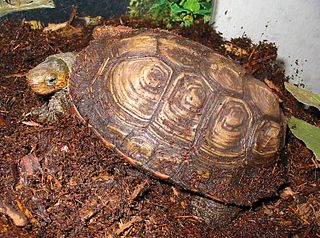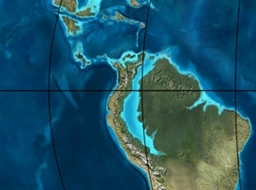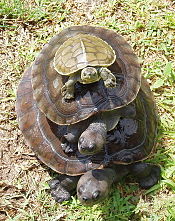
Rhinoclemmys is a genus of turtles in the family Geoemydidae, the only genus in the subfamily Rhinoclemmydinae. Member species of the genus are commonly known as the Neotropical wood turtles and are the only geoemydids known from the Americas. As such, they have adapted to a wide range of habitats, which is reflected in the species' common names.

Titanoboa is an extinct genus of very large snakes that lived in what is now La Guajira in northeastern Colombia. They could grow up to 12.8 m (42 ft) long and reach a weight of 1,135 kg (2,500 lb).
The Peligran age is a period of geologic time within the Paleocene epoch of the Paleogene, used more specifically with South American land mammal ages (SALMA). It follows the Tiupampan and precedes the Riochican age.

The Itaboraian age is a period within the Early Eocene geologic time epoch of the Paleogene, used more specifically with South American land mammal ages (SALMA). It follows the Riochican and precedes the Casamayoran age.
The Friasian age is a period of geologic time within the Early Miocene epoch of the Neogene, used more specifically within the SALMA classification of South America. It follows the Santacrucian and precedes the Colloncuran age.
The Colloncuran age is a period of geologic time within the Middle Miocene epoch of the Neogene, used more specifically within the SALMA classification in South America. It follows the Friasian and precedes the Laventan age.
Tsoabichi is an extinct genus of caiman crocodylian. Fossils are known from the Green River Formation in Wyoming, and date back to the Wasatchian stage of the Eocene. The genus was named and described in 2010 by paleontologist Christopher A. Brochu, with the type species being Tsoabichi greenriverensis. According to the current understanding of caiman evolutionary relationships, Tsoabichi is a basal member of Caimaninae and may have evolved after caimans dispersed into North America from northern and central South America, their main center of diversity in the Cenozoic.
Aguascalientia panamaensis is an extinct species of miniature camels found in Panama first described by Aldo F. Rincon et al. in 2012.
Culebrasuchus is an extinct genus of caiman known from the Early to Middle Miocene (Hemingfordian) of the Panama Canal Zone of Panama. It contains a single species, Culebrasuchus mesoamericanus.
Centenariosuchus is an extinct genus of caimanine crocodylian known from the Miocene of the Panama Canal Zone of Panama. It contains a single species, Centenariosuchus gilmorei, that was named in 2013 in honor of the upcoming centennial anniversary of the digging of the Panama Canal. Two fossil specimens consisting of skull fragments were found in the Early to Middle Miocene Cucaracha Formation in 2009 and 2011, and may belong to a single individual. The species is diagnosed by a combination of skull features that it shares with basal caimans like Tsoabichi, Eocaiman, Culebrasuchus, and the living genus Paleosuchus, as well as more derived caimans such as those in the genus Caiman. One feature that distinguishes Centenariosuchus from all other caimans is the straight outer margin of a hole on the underside of the skull called the suborbital fenestra. According to one phylogenetic analysis of caimanine relationships, Centenariosuchus falls within a clade or evolutionary grouping of caimans that includes the very large and highly specialized forms Purussaurus and Mourasuchus, known from the Miocene of South America.

The Cucaracha Formation (Tca) is a geologic formation in Panama. It preserves vertebrate and plant fossils dating back to the Neogene period; Early to Middle Miocene epochs (Hemingfordian). Fossils of the crocodylian Centenariosuchus, the turtle Rhinoclemmys panamaensis and the artiodactyl Paratoceras have been found in the formation.

The Gatún Formation (Tg) is a geologic formation in the Colón and Panamá Provinces of central Panama. The formation crops out in and around the Panama Canal Zone. The coastal to marginally marine sandstone, siltstone, claystone, tuff and conglomerate formation dates to the latest Serravallian to Tortonian, from 12 to 8.5 Ma. It preserves many fossils, among others, megalodon teeth have been found in the formation.

The Culebra Formation (Tcb) is a geologic formation in Panama. It preserves fossils dating back to the Miocene period; Early Miocene epoch, Aquitanian to Burdigalian stages. Fossils of Culebrasuchus have been found in and named after the formation. The thickness of the formation is at least 250 metres (820 ft) thick, and the age has been estimated as from 23 to 19 Ma.

The Gatuncillo Formation (Tgo) is a geologic formation in central Panama. The formation is exposed in the Panama Canal Zone and surrounding areas. It preserves fossils dating back to the Middle to Late Eocene period.
Etayoa is an ungulate of the family Carodniidae in the order Xenungulata that lived during the Early Eocene in northern South America.
Panamacebus is an extinct genus of monkey known from the Early Miocene of central Panama.

The Bogotá Formation (Spanish: Formación Bogotá, E1-2b, Tpb, Pgb) is a geological formation of the Eastern Hills and Bogotá savanna on the Altiplano Cundiboyacense, Eastern Ranges of the Colombian Andes. The predominantly shale and siltstone formation, with sandstone beds intercalated, dates to the Paleogene period; Upper Paleocene to Lower Eocene epochs, with an age range of 61.66 to 52.5 Ma, spanning the Paleocene–Eocene Thermal Maximum. The thickness of the Bogotá Formation ranges from 169 metres (554 ft) near Tunja to 1,415 metres (4,642 ft) near Bogotá. Fossils of the ungulate Etayoa bacatensis have been found in the Bogotá Formation, as well as numerous reptiles, unnamed as of 2017.
Bairdemys is an extinct genus of side-necked turtles in the family Podocnemididae. The genus existed from the Late Oligocene to Late Miocene and its fossils have been found in South Carolina, Puerto Rico, Panama and Venezuela. The genus was described in 2002 by Gaffney & Wood and the type species is B. hartsteini.





